How the Method Works
Recall the Chain Rule for Derivatives
Suppose you have a function like \(f(x)=(x^3+1)^5\) and you want to find \(f'(x)\). We would use the chain rule, which tells us to first derive the “outside function” \((—-)^5\), leave the inside alone, and then multiply by the derivative of the inside function. This gives you \(f'(x)= 5\cdot (x^3+1)^4\cdot 3x^2 = 15x^2\cdot (x^3+1)^4\).
Now, what if instead we were given the function \(f(x)=15x^2\cdot (x^3+1)^4\) and we are asked to antiderive it? Noting that antideriving is just “backwards deriving,” I can put on my Sherlock Holmes hat and observe that the chain rule was probably used to get the derivative \(f(x)=15x^2\cdot (x^3+1)^4\) because the derivative of the inside is \(3x^2\) which is close to what we have on the outside. So, in order to antiderive this, if I could somehow work backwards by removing the derivative of the inside function from that \(15x^2\) on the outside and then antiderive the outside \((—-)^5\), that would give me an antiderivative of \(f(x)\). This idea is entirely encapsulated in the idea of U-Substitution given explicitly below.
First we identify the inside function and call it \(u\):
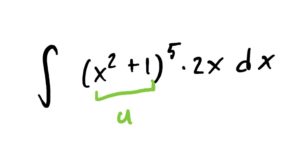
Then we derive our \(u=x^2+1\) to get \(\frac{du}{dx}=2x\). Now, every place we see \(x^2+1\) we will replace it with a \(u\) and every place we see \(2x\) we will replace it with \(\frac{du}{dx}\), and then “cancel” the \(dx\)’s.
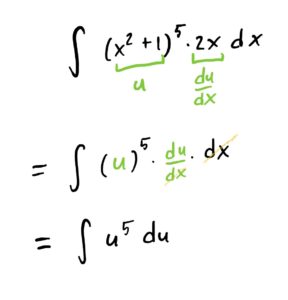
Now that we have no \(x\)’s in the integrand and only have \(u\)’s, we will antiderive the current integrand in terms of \(u\) as usual:
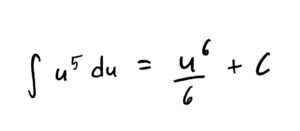
Lastly, we replace all \(u\)’s with \(x^2+1\) to get the final answer (because the original problem was in terms of \(x\), not these \(u\)’s that we substituted to help with the problem).
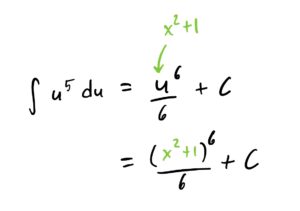
Making alterations to the \(\frac{du}{dx}\) Equation
Suppose we want to find \(\int (x^5+3)^6\cdot x^4\ dx\). Now if we let \(u=x^5+3\), then \(\frac{du}{dx}=5x^4\) which is NOT EXACTLY what we have being multiplied on the outside. As such, we cannot carry out the substitution just yet because of this mismatch. We need to make a few alterations to the \(\frac{du}{dx}\) equation before we can substitute. This is illustrated in the quick example below.
Let \(u=x^5+3\). Then note that \(\frac{du}{dx}=5x^4\). Since we have \(x^4\) in the integrand, we will get \(x^4\) by itself on one side of the equation \(\frac{du}{dx}=5x^4\) so we have something to replace the \(x^4\) with. Thus, we have:

Now we can replace \(x^5+3\) with \(u\) and \(x^4\) with \(\frac{1}{5}\cdot \frac{du}{dx}\) respectively. This gives us

Now we can antiderive as usual in terms of \(u\), bringing the \(\frac{1}{5}\) along for the ride.
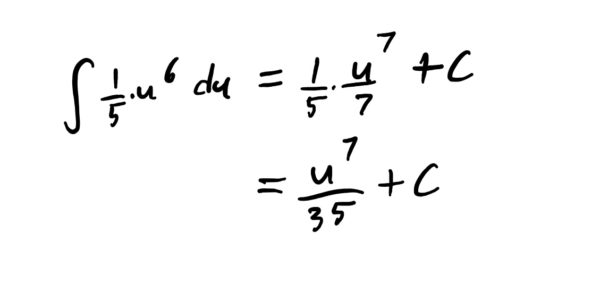
Lastly, we replace the \(u\) with the original \(x^5+3\) and call it a day:
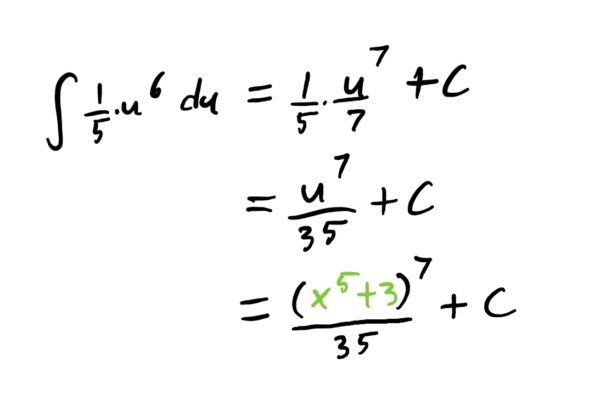
Compute the following antiderivatives
Let \(u=x^3+1\)
- First find an “inside function” and let it be called \(u\).
- Find the derivative of \(u\), \(\frac{du}{dx}\)
- Find where the expressions you have for \(u\) and \(\frac{du}{dx}\) appear in the integral and replace them in the integrand with \(u\) and \(\frac{du}{dx}\). You may need to first rearrange the equations for \(u\) or \(\frac{du}{dx}\) before substituting. Your integral should have no \(x\)’s anymore after subbing.
- integrate as usual. Don’t forget “+C”
- plug back in your \(u\) formula and call it a day
- (If computing a definite integral, then plug in upper and lower limits in for \(x\), and subtract the results.)
\(\frac{(x^3+1)^{21}}{21}+C\)
Let \(u=2x+1\)
- First find an “inside function” and let it be called \(u\).
- Find the derivative of \(u\), \(\frac{du}{dx}\)
- Find where the expressions you have for \(u\) and \(\frac{du}{dx}\) appear in the integral and replace them in the integrand with \(u\) and \(\frac{du}{dx}\). You may need to first rearrange the equations for \(u\) or \(\frac{du}{dx}\) before substituting. Your integral should have no \(x\)’s anymore after subbing.
- integrate as usual. Don’t forget “+C”
- plug back in your \(u\) formula and call it a day
- (If computing a definite integral, then plug in upper and lower limits in for \(x\), and subtract the results.)
\(\frac{(2x+1)^{301}}{602}+C\)
Let \(u=3x+5\)
- First find an “inside function” and let it be called \(u\).
- Find the derivative of \(u\), \(\frac{du}{dx}\)
- Find where the expressions you have for \(u\) and \(\frac{du}{dx}\) appear in the integral and replace them in the integrand with \(u\) and \(\frac{du}{dx}\). You may need to first rearrange the equations for \(u\) or \(\frac{du}{dx}\) before substituting. Your integral should have no \(x\)’s anymore after subbing.
- integrate as usual. Don’t forget “+C”
- plug back in your \(u\) formula and call it a day
- (If computing a definite integral, then plug in upper and lower limits in for \(x\), and subtract the results.)
\(\frac{(3x+5)^{3.5}}{10.5}+C\)
Let \(u=x^2+x\). Also, convert radical to fractional power.
- First find an “inside function” and let it be called \(u\).
- Find the derivative of \(u\), \(\frac{du}{dx}\)
- Find where the expressions you have for \(u\) and \(\frac{du}{dx}\) appear in the integral and replace them in the integrand with \(u\) and \(\frac{du}{dx}\). You may need to first rearrange the equations for \(u\) or \(\frac{du}{dx}\) before substituting. Your integral should have no \(x\)’s anymore after subbing.
- integrate as usual. Don’t forget “+C”
- plug back in your \(u\) formula and call it a day
- (If computing a definite integral, then plug in upper and lower limits in for \(x\), and subtract the results.)
\(\frac{4(x^2+x)^{\frac{3}{2}}}{3}+C\)
Let \(u=x^2+4\)
- First find an “inside function” and let it be called \(u\).
- Find the derivative of \(u\), \(\frac{du}{dx}\)
- Find where the expressions you have for \(u\) and \(\frac{du}{dx}\) appear in the integral and replace them in the integrand with \(u\) and \(\frac{du}{dx}\). You may need to first rearrange the equations for \(u\) or \(\frac{du}{dx}\) before substituting. Your integral should have no \(x\)’s anymore after subbing.
- integrate as usual. Don’t forget “+C”
- plug back in your \(u\) formula and call it a day
- (If computing a definite integral, then plug in upper and lower limits in for \(x\), and subtract the results.)
\(\frac{-(x^2+4)^{-3}}{6}+C\)
Let \(u=x-20\)
- First find an “inside function” and let it be called \(u\).
- Find the derivative of \(u\), \(\frac{du}{dx}\)
- Find where the expressions you have for \(u\) and \(\frac{du}{dx}\) appear in the integral and replace them in the integrand with \(u\) and \(\frac{du}{dx}\). You may need to first rearrange the equations for \(u\) or \(\frac{du}{dx}\) before substituting. Your integral should have no \(x\)’s anymore after subbing.
- integrate as usual. Don’t forget “+C”
- plug back in your \(u\) formula and call it a day
- (If computing a definite integral, then plug in upper and lower limits in for \(x\), and subtract the results.)
\(10(x-20)^{\frac{1}{2}}+C\)
Let \(u=3x+1\)
- First find an “inside function” and let it be called \(u\).
- Find the derivative of \(u\), \(\frac{du}{dx}\)
- Find where the expressions you have for \(u\) and \(\frac{du}{dx}\) appear in the integral and replace them in the integrand with \(u\) and \(\frac{du}{dx}\). You may need to first rearrange the equations for \(u\) or \(\frac{du}{dx}\) before substituting. Your integral should have no \(x\)’s anymore after subbing.
- integrate as usual. Don’t forget “+C”
- plug back in your \(u\) formula and call it a day
- (If computing a definite integral, then plug in upper and lower limits in for \(x\), and subtract the results.)
\(\frac{2(3x+1)^{\frac{1}{2}}}{3}+C\)
Let \(u=x^3+\frac{3}{2}x^2\)
- First find an “inside function” and let it be called \(u\).
- Find the derivative of \(u\), \(\frac{du}{dx}\)
- Find where the expressions you have for \(u\) and \(\frac{du}{dx}\) appear in the integral and replace them in the integrand with \(u\) and \(\frac{du}{dx}\). You may need to first rearrange the equations for \(u\) or \(\frac{du}{dx}\) before substituting. Your integral should have no \(x\)’s anymore after subbing.
- integrate as usual. Don’t forget “+C”
- plug back in your \(u\) formula and call it a day
- (If computing a definite integral, then plug in upper and lower limits in for \(x\), and subtract the results.)
\(\frac{(x^3+\frac{3}{2}x^2)^\frac{2}{3}}{2}+C\)
Let \(u=\sqrt{x}+1\). It would also be helpful to convert radicals to fractional powers
- First find an “inside function” and let it be called \(u\).
- Find the derivative of \(u\), \(\frac{du}{dx}\)
- Find where the expressions you have for \(u\) and \(\frac{du}{dx}\) appear in the integral and replace them in the integrand with \(u\) and \(\frac{du}{dx}\). You may need to first rearrange the equations for \(u\) or \(\frac{du}{dx}\) before substituting. Your integral should have no \(x\)’s anymore after subbing.
- integrate as usual. Don’t forget “+C”
- plug back in your \(u\) formula and call it a day
- (If computing a definite integral, then plug in upper and lower limits in for \(x\), and subtract the results.)
\(\frac{2(x^{\frac{1}{2}}+1)^3}{3}+C\)
